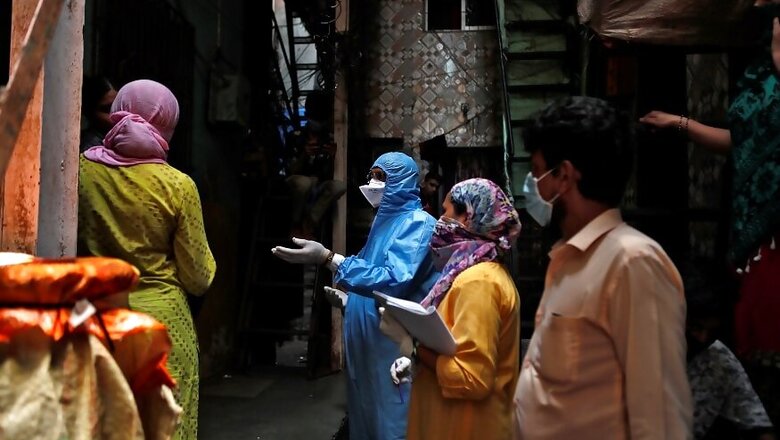
views
The country's first sero-survey to monitor the trend of coronavirus transmission found that lockdown and containment measures were successful in preventing rapid spread of the disease, but a large proportion of the population still remains susceptible, the government said on Thursday.
The first part of the study conducted by the Indian Council of Medical Research revealed that 0.73 per cent of the population surveyed showed evidence of past exposure to SARS-CoV-2, and that urban slum population was the most vulnerable to the infection, ICMR Director General Balram Bhargava said at a press conference.
"A large proportion of the population is still susceptible and the risk is higher in urban areas (1.09 times) and urban slums (1.89 times) than rural areas," he said.
He said the study surveyed a total of 83 districts with 26,400 people enrolling for it and 28,595 households were visited. The surveyed districts were categorised into — zero cases, low incidence, medium incidence and high incidence — and these were selected based on incidence of reported COVID-19 cases as on April 25.
The slides shared with the media stated that data from 65 districts has been compiled till now.
As part of the survey, 3 to 5 ml of blood samples were taken from individuals and tested for IgG antibodies and infection using ELISA test kits developed by the ICMR-National Institute of Virology (NIV), Pune.
The sero-survey has two parts, that is, estimating the fraction of population infected with SARS-CoV-2 in general population, and estimating the number of population infected with coronavirus in containment zones of hotspot cities, Bhargava said.
The first part of the survey has been completed and the second part is ongoing, he said, adding the study was conducted in May by the ICMR in collaboration with state health departments, National Centre for Disease Control and the World Health Organisation.
"The sero-survey has found that 0.73 per cent of the population in the districts surveyed had evidence of past exposure to SARS-CoV-2," the ICMR director general said.
"Lockdown and containment (measures) have been successful in keeping it low and preventing rapid spread," he said.
The survey found that the infection fatality rate is very low at 0.08 per cent, he said.
However, the infection in containment zones was found to be high with significant variations, but the survey is still ongoing, he said.
The official said since a large proportion of the population is susceptible and the infection can spread, non-pharmacological interventions such as physical distancing, use of face masks or covers, hand hygiene, cough etiquette etc must be followed strictly.
Urban slums are highly vulnerable for the spread of the infection and local lockdown measures need to continue as already advised by the government, he said.
The elderly, those with chronic morbidities, pregnant women and children less than 10 years of age need to be protected as they fall in the "high-risk category" susceptible to COVID-19, Bhargava said.
Terming it as the "largest sero-epidemiological survey" in the world conducted in the context of COVID-19, V K Paul, chairman of Empowered Group One and NITI Aayog member, said such findings help fine-tune the response and strategies to deal with the COVID-19 challenge.
The results indicate the situation of the country around April 30 as the antibodies against an infection take around 15 days to develop.
"The prevalence of the infection was found to be in less than one per cent of the population surveyed. It is a big achievement for such a big country if the pandemic has been suppressed at such a level," Paul said.
He also stressed on seeking care early, timely detection and proper clinical management of cases, saying the fight can last for several months.
"But this sero-survey findings have definitely given us confidence," Paul added.
Bhargava said more such surveys will be conducted and even states will be doing such studies.
"We will share the findings of the second part of the survey which is focusing on containment zones with states to help them assess if they have to change their strategies. The purpose is to guide the policy makers on how we can best contain this problem in the country," he added.
Responding to a question about patients being turned away by hospitals, especially those requiring ICU and oxygen support, Joint Secretary in the health ministry Lav Agarwal said symptomatic persons or suspect cases should get in touch with states' helpline numbers and try to access the hospital facilities as advised.
"In addition to this, we have requested the states to streamline the helpline system, provide guidance and also display the status of beds using tehcnology," he said.
Asked about disparity in death figures given out by the MCD and Delhi government, Agarwal said the ministry compiles the fatality figures on the basis of the methology used by states.
"In some cases, states said they want to analyse the casualities and conduct a death audit to find out the causes of the death. We only bring the data given to us by states transparently," he added.
India saw the highest single-day spike of 357 fatalities and 9,996 cases, pushing the death toll to 8,102 and the nationwide tally to 2,86,579 on Thursday.




















Comments
0 comment